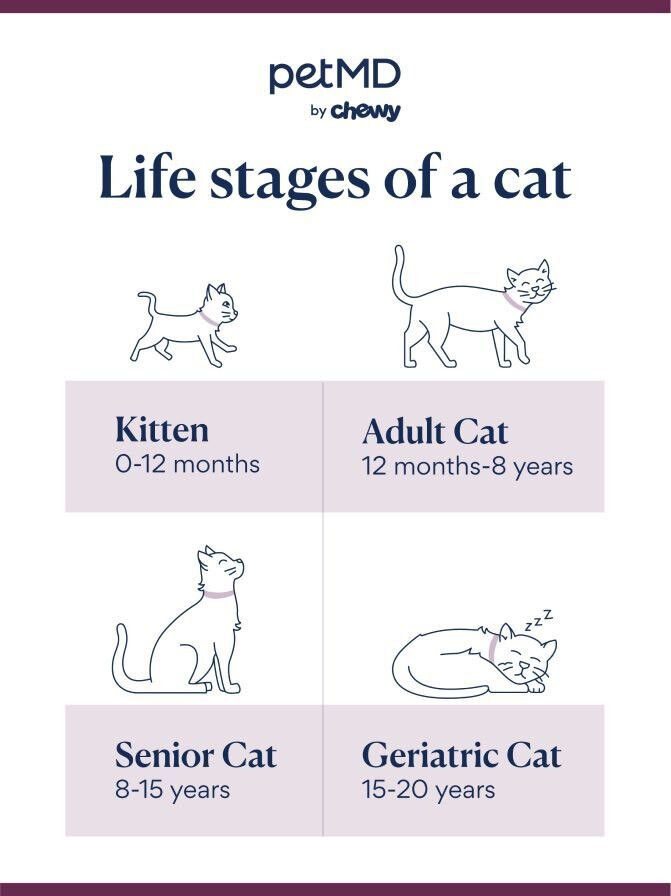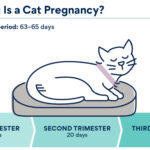Thanks to advancements in veterinary medicine, improved nutrition, and dedicated pet care, our feline companions are living longer and healthier lives than ever before. As responsible cat owners, it’s our role to support our cats through each stage of their lives, maximizing their chances of reaching those cherished golden years.
If you’ve ever wondered about your cat’s age in human years or pondered the typical lifespan of a cat, the answer is multifaceted. It hinges significantly on the partnership between you and your veterinarian in addressing your cat’s nutritional needs, vaccination schedules, oral hygiene, and environmental requirements as they mature.
This guide provides a comprehensive overview of the average lifespan of cats and actionable steps you can take to help your beloved cat live a longer, healthier, and happier life.
What is the Average Cat Age Expectancy?
The typical Cat Age Expectancy falls between 13 and 17 years. Remarkably, some cats exceed this average, living for 20 years or even longer. Creme Puff, a celebrated feline holding the world record for the oldest cat ever documented, lived an astonishing 38 years.
Several key factors play a crucial role in determining a cat’s lifespan. These include:
- Nutrition: A complete and balanced diet is foundational for a long life. It supplies the essential nutrients, vitamins, and minerals cats need to support optimal organ function, a robust immune system, and a healthy body weight.
- Lifestyle: A cat’s lifestyle profoundly impacts their longevity. Indoor cats generally outlive outdoor cats due to reduced exposure to environmental hazards and consistent access to preventive veterinary care, provided by their attentive owners.
- Preventive Care: Cats receiving complete vaccinations and undergoing routine health screenings, including blood work, benefit from early detection and treatment of potential health issues. Regular preventive medications against fleas, ticks, and heartworm are also vital for extending a cat’s lifespan by preventing parasite-borne diseases.
- Breed: Certain cat breeds exhibit different average lifespans. For instance, Siamese cats are often associated with fewer breed-specific health problems and tend to live longer compared to breeds like Maine Coons. Larger breeds like Maine Coons can be predisposed to certain health issues due to their size, potentially affecting their lifespan.
- Genetics: A cat’s genetic makeup and predisposition to specific health conditions can influence their lifespan. Genetic testing is a valuable tool, particularly for breeders, to identify and mitigate potential inherited health issues.
- Spaying/Neutering: Spaying or neutering your cat is strongly linked to increased lifespan compared to intact cats. Unspayed or unneutered cats face a higher risk of developing reproductive cancers and other hormone-related health problems.
 cat life stages; how long do cats live
cat life stages; how long do cats live
Indoor vs. Outdoor Cat Age Expectancy
Sadly, the age expectancy for outdoor cats, or those with frequent outdoor access, is significantly lower, averaging only about half that of indoor cats. Outdoor environments present numerous dangers to cats, including:
- Infectious Diseases: Exposure to diseases from wildlife and other cats.
- Trauma: Risks of injury from predators or vehicle accidents.
- Parasites: Higher susceptibility to fleas, ticks, and internal parasites.
While some cats might benefit emotionally and behaviorally from controlled outdoor experiences like leash walks or secure enclosures, most cats thrive as indoor-only pets, especially when provided with an appropriately enriched indoor environment. Indoor cats benefit from a protected environment, shielding them from common dangers and ensuring consistent access to quality nutrition, contributing to a longer cat age expectancy.
Cat Life Stages and Age Expectancy
As cats progress through life, they enter distinct life stages, each with unique behavioral and health considerations. Understanding these stages is key to providing stage-appropriate care and maximizing your cat’s potential lifespan.
Kitten (Birth to 1 Year)
The kitten stage is defined by rapid growth and learning as kittens explore and adapt to their surroundings. This early period is crucial for establishing a foundation for a healthy and well-adjusted adult cat.
While kittens instinctively learn basic habits like using the litter box and eating, socialization and engaging in enriching play are essential for their behavioral development. Interactive toys, such as a cat laser pointer, are excellent for stimulating their minds and encouraging physical activity.
Nutritionally, kittens require a diet specifically formulated for growth, as their caloric needs are higher to support their rapid development. Look for cat food labels with an Association of American Feed Control Officials (AAFCO) nutritional adequacy statement indicating “complete nutrition for growing kittens.”
Kittenhood is also the time for initial vaccinations, protecting them from common feline diseases. Core vaccines like FVRCP (feline viral rhinotracheitis, calicivirus, and panleukopenia), rabies, and FeLV (feline leukemia virus) are typically administered during this stage. Spaying or neutering is recommended around 6 months of age, minimizing the risk of certain cancers and undesirable behaviors like urine marking.
Young Adult (1–6 Years)
Young adult cats remain active and playful but have completed their physical growth. Their caloric needs decrease, and they should transition to adult cat food. Maintaining a healthy weight during this stage is crucial for preventing future health issues such as arthritis and diabetes. Careful weight management contributes to a longer and healthier cat age expectancy.
Continuing routine vaccinations and annual veterinary checkups are important, even though young adult cats are generally healthy. However, certain conditions like asthma and feline lower urinary tract disease (FLUTD) are more commonly diagnosed in this age group. Early detection through regular vet visits and blood work allows for timely intervention and better long-term management of these conditions.
Mature Adult (7–10 Years)
Mature adult cats may exhibit a gradual decrease in activity levels, becoming less playful and potentially more sedentary. Changes in behavior, such as altered litter box habits or increased nighttime activity, may become noticeable. Some older cats may become more active at night and sleep more during the day, while others may become less meticulous about their bathroom habits.
Providing an accessible litter box, such as an uncovered litter box with low sides, can aid senior cats, particularly those with mobility challenges. These changes can sometimes indicate underlying health issues like arthritis, cognitive dysfunction, or early kidney or digestive problems. Annual blood work becomes increasingly important for mature cats to monitor for early changes in kidney, liver, and thyroid function.
Regular monitoring of grooming habits, hairball frequency, and weight fluctuations is also recommended. Oral health becomes a significant focus, and dental cleanings should be considered based on veterinary recommendations, especially for cats resistant to home dental care like tooth brushing. Establishing a routine for pet dental care, including finding a suitable pet toothbrush and toothpaste, is beneficial for long-term oral health and potentially reducing the need for frequent professional cleanings, contributing to overall cat age expectancy.
Senior (11+ Years)
The transition to the senior cat stage is variable; some cats remain active and mobile well into their senior years, while others experience more age-related health issues. For cats aged 11 years and older, biannual veterinary checkups, including blood work and urine testing every six months, are recommended due to the increased risk of organ function changes. Senior cats are also more prone to developing high blood pressure, which can lead to serious complications like strokes and blindness. Blood pressure monitoring should be part of routine senior cat checkups.
Senior cats often exhibit further slowing down, which can be a sign of untreated arthritis pain. If not already implemented, joint supplements, as recommended by a veterinarian, can help support joint health and mobility.
How To Increase Your Cat’s Age Expectancy
While there’s no magic formula to guarantee immortality for our cats, there are numerous proactive steps pet owners can take to significantly improve their cat’s chances of a longer and healthier life.
- Stay Up-to-Date on Vaccinations: Vaccinations tailored to your cat’s lifestyle are crucial for preventing potentially life-threatening diseases. It’s important to remember that even indoor cats require vaccinations to protect them from diseases they could be exposed to.
- Spay or Neuter Early: Spaying or neutering your cat at a young age dramatically reduces the risk of reproductive diseases and cancers, contributing to a longer cat age expectancy.
- Commit to Preventive Care: Cats are adept at masking signs of illness. Annual veterinary checkups and routine blood testing are vital for early disease detection. A strong veterinarian-client-patient relationship allows your vet to recognize subtle changes in your cat’s health during examinations. Always discuss any behavioral changes with your veterinarian, even if they seem minor.
- Adapt Your Cat’s Environment: As cats age, modifying their environment to meet their changing needs is important. Discuss joint supplements with your vet if you notice your cat slowing down. Consider providing an orthopedic bed to offer enhanced support and comfort for aging joints.
By prioritizing these aspects of cat care, you can play an active role in maximizing your cat’s age expectancy and ensuring they enjoy a fulfilling and healthy life for many years to come.

